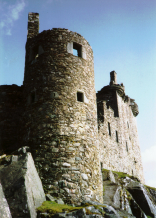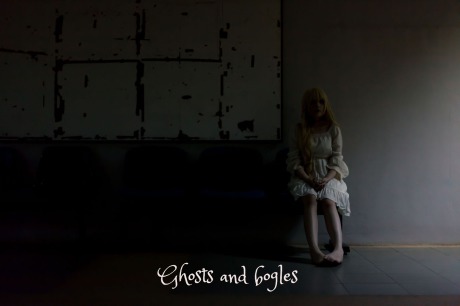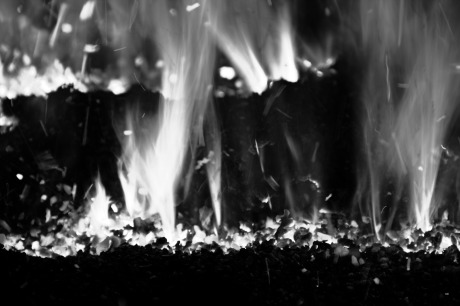Evil Spirits: Ring Croft of Stocking, Glenluce and Galdenoch
Although many seem to believe differently – and going against what some people who arrange ghost tours will tell their customers – ghosts very rarely harm the living, except perhaps by scaring them a bit. Of all the cases of hauntings in Scotland, only a handful involve any kind of physical or corporeal violence.
But there are, of course, exceptions, and three cases from the southwest of Scotland are exceptional, vigorous and unpleasant manifestations of what is often called poltergeist activity. That is, the movement of objects, noises, fire raising and much else.
These cases come from the seventeenth century, a turbulent time of religious conflict, which may explain the violence of the hauntings. They were also recorded by men who had some motive in exaggerating the events, partly religious by ministers hoping to convince their congregations of the reality of evil, partly financial by the publishers of pamphlets wanting to sell more copies.
The first case concerns Ring Croft of Stocking, a farm which once stood just to the west of the village of Auchencairn in the old county of Kirkcudbrightshire, near the present Collin Farm. The farm was occupied by Andrew Mackie, a mason and farmer, and his family in 1695.
An account of the haunting was made by the local minister, Alexander Telfair, and was issued in pamphlet form under the title: ‘A True Relation of an Apparition, Expressions and Actings of a Spirit, which infested the house of Andrew Mackie in Ringcroft of Stocking, in the paroch [parish] of Rerrick, in the Stewarty of Kirkcudbright’.
The events were attested to by fifteen witnesses, including Telfair, as well as five other ministers, who all signed the original document.
The episode started in February, rather mischievously. On consecutive mornings Mackie found that his beasts had been freed from their tethers in the byre, despite tying them up carefully the previous evening – and using stronger tethers. Mackie moved the animals from the byre but then found one of the beasts tied tightly to a beam of his house. A few days later Mackie discovered a stack of peats had been piled into the middle of the dwelling and had then had been lit, although he managed to extinguish it before any damage was done. There was no obvious explanation for these odd occurrences.
Manifestations then began to escalate. From the 7th of March that year, stones were thrown at the family as they dwelt in the house, although it was impossible to determine from where these came. This was worse at night and continued for four days. On the 11th of March, while the adults were out working, the children returned to the farm to find what they thought was a shrouded figure sitting by the fire; when they removed the blanket they found only an upturned stool.
Items then went missing and the stone throwing began again, being especially bad on a Sunday. Those praying were particularly targeted.
Mackie asked the minister, Alexander Telfair, to intervene. Telfair questioned Mackie and his family regarding anything that they might have done to have angered anyone, alive or dead, but it seems that Mackie was an upright fellow and no explanation could be found. When the minister was at the farm, nothing happened until he left the house and the stone throwing began again. He went into pray and was struck himself, but then disturbances ceased until the next Sunday.
The missiles became heavier (although injuries sustained were slighter than might be expected from the weight of the stones) and the bombardment went on for nearly three days. Telfair and some of Mackie’s neighbours came to pray, but the minister was struck repeatedly by rocks and was also hit on the back. Knocking was heard and the side of a box-bed was torn off. Telfair reported seeing ‘a little white Hand and Arm from the elbow down, but presently it vanished’.
On several occasions the family and neighbours saw the apparition of what appeared to be a teenage lad, dressed in grey and wearing a bonnet. It is not clear, however, if this had anything to do with the haunting.
The following day things got worse again. People were hit with heavy stones and beaten with staves, until they had to leave the house. Some were dragged along the floor, others were scratched as if by fingernails. That night the children were attacked, their blankets thrown off them and then beaten about the hips as if slapped by a hand. The bar for the door moved about the room on its own, furniture shook and more stones rained down.
On the 4th of April the word ‘Wisht!’ was repeatedly heard when the family finished a sentence of a prayer, and whistling plagued the building. More ministers were called in, but they were hit, causing wounds and bruises, and hot peats from the fire were thrown at them.
Fires began to be lit the next day in the straw, and more and more people came from the neighbourhood to experience the manifestations: they were duly pelted with stones.
Mackie’s wife disturbed a part of the floor at the threshold of the house, and found beneath it:
‘Seven small bones, with Blood, and some Flesh, all closed in an Old suddled Paper, the Blood was fresh and bright: the sight whereof troubled her, and being afraid, laid all down again.’
The woman was much troubled by this discovery and went for advice. Meantime, the activity again intensified. Witnesses saw fireballs, although these went out before igniting anything, and a red hot stone was tossed in the children’s bed and burnt through the blankets. A staff was shoved into the wall above their bed.
Eventually the bones were picked up and were taken to the minister. After returning, initially Telfair was showered with large stones – but then the activity lessened.
The next day, another Sunday, the stone throwing began again, along with movement of other heavy items. Fires were started but were put out by neighbours. One of the children was illuminated by an unearthly radiance, which followed him into the house.
The following morning Mackie found a letter outside the house. It was bedaubed in blood and appeared to accuse an unnamed resident of the house of murder. All those who had lived there were brought to the farm but no determination of guilt could be made, even after they had all touched the bones (known as a ‘beirricht’, a way of trying to find the culprit: if the murderer was present the remains would ooze blood).
Five ministers decided to stay in the house, along with local men, praying and fasting. They were, of course, attacked with large stones and a hole was made through the thatch of the roof and the barn door was smashed along with part of the wall. They also felt as if they a hand was clasped around the legs.
Things did not improve, not matter how much praying they did.
When a man brought a dead polecat (killed by his dog on the way to the farm) into the house, they were all beaten with it, and a man felt as if a hand was thrust into his pocket and was so scared he vomited. A spade and a sieve were thrown about, and the whistling returned along with shouted words.
At this point, on the 16th of April, the Mackies finally left their house, although why it had taken until then seems madness on their part.
Activity diminished except for some trouble with the cattle, and when they came back little initially happened.
Within a few days, however, all hell was let loose: people were again pelted with rocks, fires were started, mud was thrown in the face of those at prayer, and people were beaten with staves. A voice also began to curse and shout at them, swearing that they were witches and rooks – and telling them they would be taken to Hell.
Mackie held a conversation with the spirit, and a voice said to him:
‘God gave me a commission, and I am sent to warn you the land to repent; for a judgement is to come if the land do not quickly repent, and I will return a hundred times worse upon every family in the land.’
Then it said, ‘Praise me, and I will whistle to you. Worship me, and I will trouble you no more’.
Mackie refused and the next day, a Sunday, the house was set on fire no less than seven times, although again they managed to extinguish the flames. One of the gables of the house was then demolished, and those present retired to the stable. But the violence followed them. One of the children was dragged from their resting place, and a beam was then suspended above the others, with the words,
‘If I had a commission I would brain them!’
That Monday the fire raising continued, no matter that they had removed all combustible material from around the farm.
The next day, when they were praying in the barn, they saw a black shape in one corner, which grew and slowly filled the whole building, although no features could be discerned. Mud was thrown at those attending. People felt their limbs and torsos gripped by strong hands, which left an ache for days. Then the black shape faded away.
The sheep house was torched on that Wednesday and, although the flock was saved, the building was burnt out.
This was, however, the final act in a bizarre series of violent and unexplained manifestations.
Nor is there any answer, either to why the activity started or to why it so suddenly stopped.
Some forty years earlier, the house of the weaver Gilbert Campbell was plagued by similar poltergeist activity for several months in 1655. Campbell lived and worked in the village of Glenluce in Galloway, which lies about thirty-five miles to the west of Ringcroft of Stocking. The events were eventually published in Satan’s Invisible World Discovered, some thirty years later, based on a work of 1672 called Hydrostaticks, written by George Sinclair.
The episode seems to have begun when a beggar called Andrew Agnew came to Campbell’s door, looking for charity. He was sent away without receiving anything and he cursed the family, saying that harm would come to them. This may not, of course, had anything to do with the subsequent ghostly activity, except that the manifestation suddenly stopped when Agnew was hanged.
Gilbert Campbell’s young daughter, called Janet (or Jennet), started to hear shrill whistling, although others were oblivious of the noise. A neighbour heard Janet say, ‘I will cast thee, Jennet, into the well,’ believing that an evil spirit was speaking through her.
Like at Ringcroft of Stocking, the house was then peppered with stones. Hats, clothes and shoes were slashed and destroyed, sometimes while they were being worn by the family, and sheets and cloths were shredded. Chests were opened and their contents flung about the room. Blankets were torn from sleepers.
To keep them safe, the children were removed from the home, and unexpectedly the activity ceased. And when they returned the house remained peaceful. Until, that is, Gilbert’s eldest son Thomas came back from studying in Glasgow. Then all hell broke loose again and all the violent activity restarted; the house was even set on fire.
Ministers were called in, but then could not discover the cause or the focus. A voice spoke to them, saying (among other things):
‘You lie, God shall judge you for your lying, and I and my father will come and fetch you to hell with warlock thieves,’ as well as telling the ministers it was ‘an evil spirit come from the bottomless pit of hell to vex this house, and that Satan was his father’.
This last statement came after the voice and one of the ministers had had a contest in Biblical knowledge. A hand and arm materialised, and then hit the floor repeatedly and so hard that the whole building shook.
Manifestations became worse. The children were beaten so violently that the slaps on their buttocks reverberated (although they were apparently not actually hurt). Stones were cast, household items were moved about or hidden, and the beds were set alight.
Then as abruptly as it had begin, the activity stopped and did not return after the death of Agnew.
A similar tale surrounds Galdenoch Castle, now a ruinous tower house, which stands some miles west of Stranraer and about fifteen miles from Glenluce. Galdenoch was a property of the Agnews. The date of this episode is not certain but it is likely to be the second half of the seventeenth century. The story is recorded in Hereditary Sheriffs of Galloway, written by Andrew Agnew and published in 1864.
The laird of Galdenoch was a Covenanter, and finding himself pursued by Royalist forces, he took refuge at a farm, which was only inhabited by a farmer. The farmer became suspicious of the young Agnew, and tried to prevent him from leaving. Perhaps fearing that he was to be turned over to the authorities for execution, Agnew shot the farmer, killing him. Agnew returned to Galdenoch, and no suspicion fell on him. The attack, however, was not to go unpunished and Galdenoch was apparently haunted by the vengeful spirit of the farmer.
Spinning threads were repeatedly broken, peat was put into the porridge, unpleasant stuff was mixed with food, and coals were thrown from the fire.
The most disturbing episode was when the grandmother, who had been spinning, was taken from Galdenoch and immersed in the Mill-Isle Burn, a voice apparently saying, ‘I’ll dip thee, I’ll draw thee’. The family searched for the poor woman to no avail, until the voice told them, ‘I’ve washed granny in the burn and laid her on the dyke to dry!’ They hurried off and found her naked and shivering with the cold and fear.
Ministers were called but they could not rid the castle of the spirit. Psalms were sung but the voice sang louder and drowned out the holy men. Finally a new minister with a mighty voice was called in and he battled with the voice and this time was victorious, and the manifestations ceased. The evil spirit left, admitting defeat.
© Martin Coventry 2018
text from Scotland's Ghastly Ghosts











